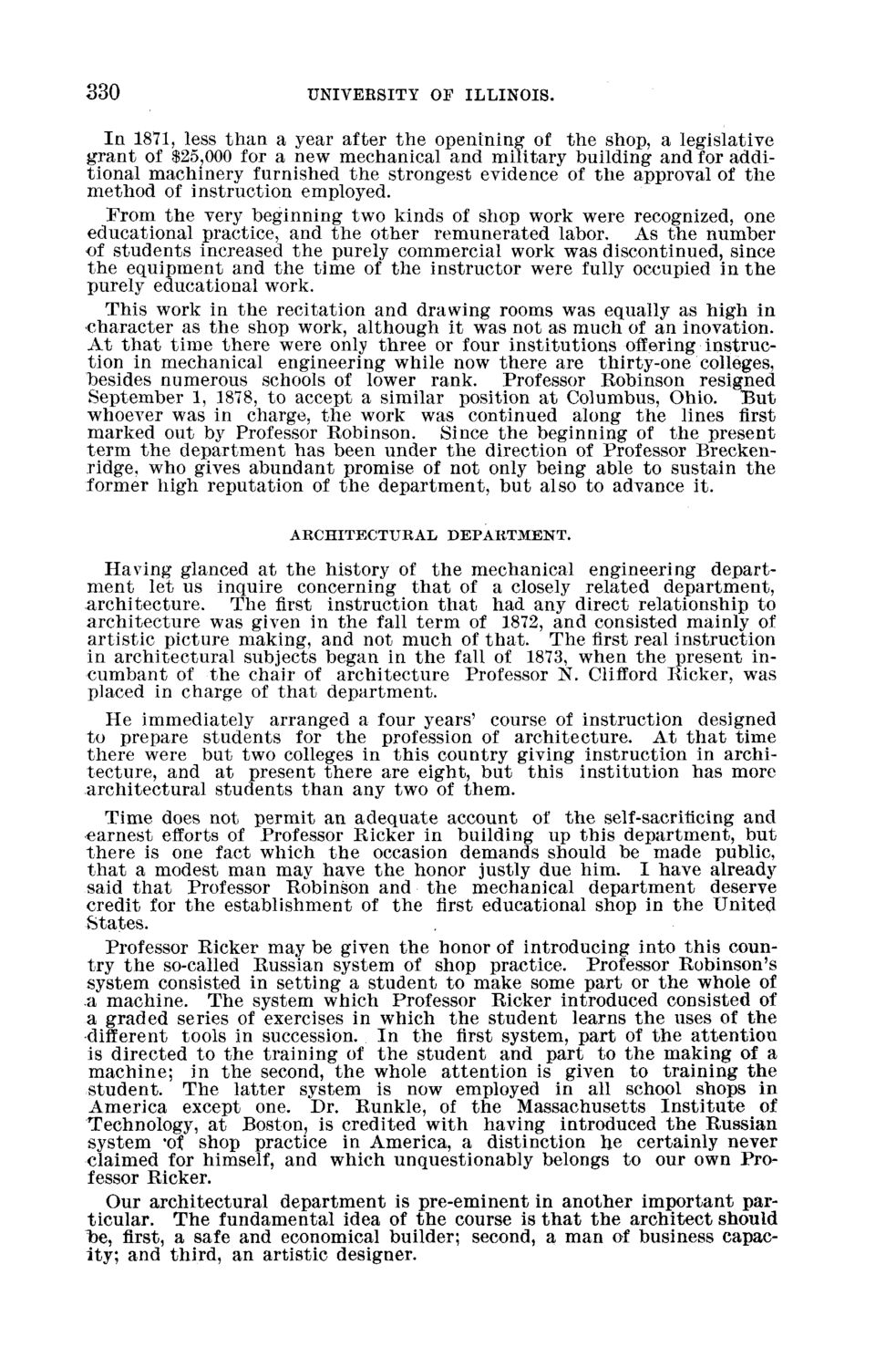| |
| |
Caption: Board of Trustees Minutes - 1894
This is a reduced-resolution page image for fast online browsing.

EXTRACTED TEXT FROM PAGE:
330 UNIVERSITY OF ILLINOIS. I n 1871, less than a year after t h e openining of the shop, a legislative grant of $25,000 for a new mechanical and military building and for additional machinery furnished the strongest evidence of the approval of t h e method of instruction employed. From the very beginning two kinds of shop work were recognized, one educational practice, and the other remunerated labor. As the number of students increased the purely commercial work was discontinued, since the equipment and the time of the instructor were fully occupied in t h e purely educational work. This work in the recitation and drawing rooms was equally as high in •character as the shop work, although it was not as much of an inovation. A t t h a t time there were only three or four institutions offering instruction in mechanical engineering while now there are thirty-one colleges, besides numerous schools of lower rank. Professor Robinson resigned September 1, 1878, to accept a similar position at Columbus, Ohio. 13ut whoever was in charge, the work was continued along the lines first marked out by Professor Robinson. Since the beginning of the present term the department has been under the direction of Professor Breckenridge, who gives abundant promise of not only being able to sustain the former high reputation of the department, but also to advance it. ARCHITECTURAL DEPARTMENT. Having glanced at the history of t h e mechanical engineering department let us inquire concerning t h a t of a closely related department, architecture. The first instruction t h a t had any direct relationship to architecture was given in the fall term of 1872, and consisted mainly of artistic picture making, and not much of that. The first real instruction in architectural subjects began in t h e fall of 1873, when t h e present incumbant of the chair of architecture Professor N. Clifford Ricker, was placed in charge of t h a t department. He immediately arranged a four years' course of instruction designed to prepare students for the profession of architecture. A t t h a t time there were but two colleges in this country giving instruction in architecture, and at present there are eight, but this institution has more architectural students than any two of them. Time does not permit an adequate account of the self-sacrificing and earnest efforts of Professor Ricker in building up this department, but there is one fact which t h e occasion demands should be made public, t h a t a modest man may have the honor justly due him. I have already said t h a t Professor Robinson and the mechanical department deserve credit for the establishment of the first educational shop in t h e United States. Professor Ricker may be given the honor of introducing into this country t h e so-called Russian system of shop practice. Professor Robinson's system consisted in setting a student to make some part or the whole of a machine. The system which Professor Ricker introduced consisted of a graded series of exercises in which the student learns the uses of the different tools in succession. I n the first system, part of the attention is directed to the training of t h e student and part to the making of a machine; in the second, the whole attention is given to training the student. The latter system is now employed in all school shops in America except one. Dr. Runkle, of the Massachusetts I n s t i t u t e of Technology, at Boston, is credited with having introduced the Russian system *of shop practice in America, a distinction he certainly never claimed for himself, and which unquestionably belongs to our own Professor Ricker. Our architectural department is pre-eminent in another important particular. The fundamental idea of t h e course is t h a t the architect should "be, first, a safe and economical builder; second, a man of business capacity; and third, an artistic designer.
| |